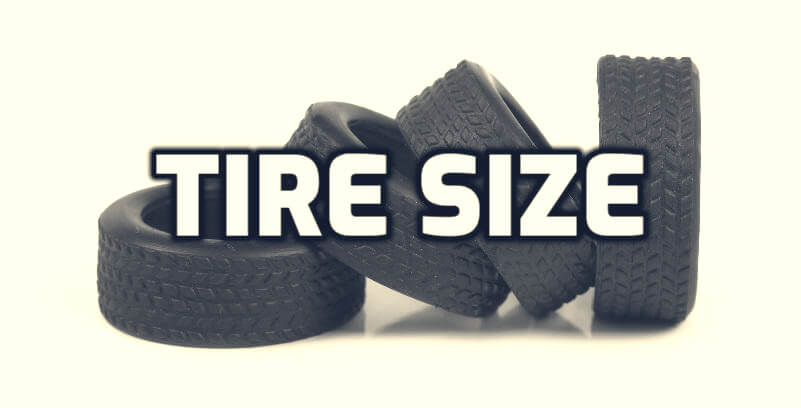What Tire Size Do I Need?

Driving a vehicle with the correct tire size is essential for optimal performance, safety, and fuel efficiency. Tires that are different from the right size for your vehicle can affect the handling, braking, and overall driving experience.
This article will guide you through the key factors to consider when choosing the right tire size for your vehicle.
Factors to Consider
Choosing the correct tire size is crucial for the safety, performance, and overall driving experience of your vehicle. Here are some important factors to consider when selecting tire size:
Vehicle Recommendations
Following the manufacturer’s recommendations for tire size and type is essential for ensuring the safety and performance of the vehicle. Using the recommended tire size helps ensure the tire can safely support the vehicle’s weight and provide the necessary traction and handling.
- Your vehicle’s owner’s manual is the primary source of information when it comes to choosing the correct tire size. It provides the manufacturer’s recommended tire size, determined based on extensive testing and engineering. Using the proper tire size ensures that your vehicle operates safely and as intended by the manufacturer.
- Following the manufacturer’s tire size recommendations is crucial, as deviating from the specified tire size can lead to decreased performance, handling issues, and possible safety concerns. Your vehicle’s suspension, braking system, and other components have been designed to work best with the recommended tire size.
Driving Conditions
Driving conditions are an important factor to consider when selecting the appropriate tire size for your vehicle. Different tire sizes and types are designed to perform optimally in different driving conditions, such as dry or wet roads, snow or ice, and off-road environments.
- Consider the type of terrain and weather conditions you typically encounter when driving. For example, if you frequently drive on rough or unpaved roads, you may need a tire with a larger diameter and a more aggressive tread pattern for better traction. Similarly, if you live in an area with heavy snowfall, you might require winter tires with a narrower width to cut through snow and maintain better contact with the road.
- If you regularly carry heavy loads or tow trailers with your vehicle, you need to consider the tire’s load capacity. A tire with a higher load-carrying capacity can handle the additional weight without compromising safety or performance. Check your owner’s manual for the recommended load range for your vehicle and choose a tire size accordingly.
Performance Preferences
Performance preferences can also play a role in choosing the appropriate tire size for your vehicle. Different tire sizes can affect handling, cornering, acceleration, and braking performance. Here are some examples of how performance preferences can influence your tire size choice:
- Tire size can have a significant impact on ride comfort. Generally, a tire with a higher aspect ratio (sidewall height relative to the tire width) will provide a smoother ride, as it can better absorb road imperfections. However, a higher aspect ratio can also lead to decreased handling and stability, particularly at higher speeds.
- If handling and stability are important, consider a tire with a lower aspect ratio and a larger diameter. These tires provide better grip and more responsive handling, particularly during cornering and at higher speeds. Remember that a lower aspect ratio can result in a harsher ride due to reduced sidewall height.
- Choosing the correct tire size can also impact your vehicle’s fuel efficiency. A too large or heavy tire can increase rolling resistance and reduce fuel economy. To optimize fuel efficiency, stick to the manufacturer’s recommended tire size and consider options with low rolling resistance technology.
Aesthetic Preferences
Aesthetic preferences can be a factor in selecting tire size, but it should not be the main factor. It is important to prioritize safety and performance over aesthetics when choosing tire size. However, some people may prefer a certain tire size for its appearance or to match the style of their vehicle. Here are some considerations when choosing tire size for aesthetic purposes:
- Your choice of tire size can impact the overall appearance of your vehicle. Larger diameter tires paired with larger wheels can give your vehicle a more aggressive, sporty look. However, it’s essential to ensure that any tire and wheel size changes do not negatively impact your vehicle’s performance or safety.
- Consider how it may affect your vehicle’s look and stance when considering a different tire size. A larger or smaller tire can alter the vehicle’s ground clearance, wheel well fitment, and overall proportions. It’s important to strike a balance between aesthetics and functionality when choosing a tire size.
Conclusion
Selecting the right tire size is crucial for maintaining your vehicle’s performance, safety, and fuel efficiency. When choosing the appropriate tire size, it’s essential to consult your vehicle’s owner’s manual and adhere to the manufacturer’s recommendations.
Additionally, consider your driving conditions, performance preferences, and aesthetic desires. By carefully considering these factors, you can ensure your vehicle operates optimally and safely while meeting your specific needs and preferences.

